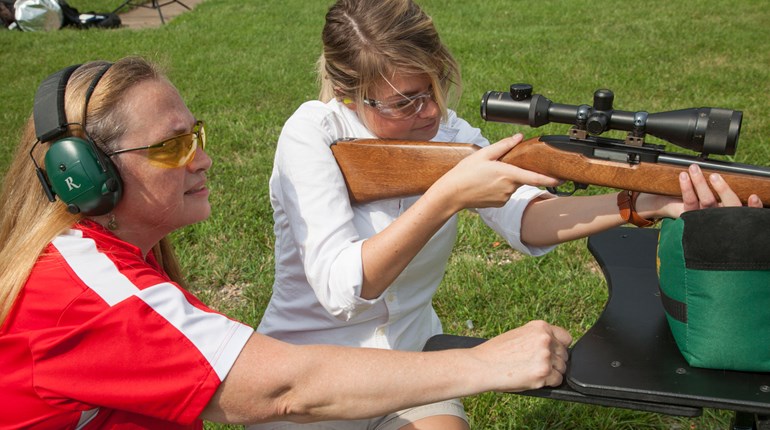
You may have heard the terms knockdown power, hydrostatic shock and kinetic energy. These concepts are usually mentioned in conjunction with the “best cartridge” discussion. What is the truth about these three concepts? Do they really exist or are they just talking points?
Truth is, once you understand them, it can help you choose the right ammunition.
What is Kinetic Energy?
Kinetic energy is the energy that an object possesses when it is in motion. In relation to firearms, or more specifically the bullet or projectile, kinetic energy is the energy a bullet possesses when it is in motion. This is calculated by dividing its mass by 2, multiplied by its velocity squared (KE=1/2 mv squared).
When applying this force to firearms, kinetic energy is referred to as “muzzle energy” when the projectile exits the barrel. The muzzle energy (ME) is the measure of a bullet’s potential for destruction. There are a lot of variables that are factored in this measurement. Generally speaking, the higher the mass (weight of the bullet) and the higher the velocity (speed in feet per second), the higher the kinetic energy and the higher the potential for destruction. This in turn should result in higher tissue damage and destruction of vital organs.
There are other factors that can affect kinetic energy that can determine what makes a good cartridge. These include Sectional Density (SD) and Ballistic Coefficient (BC). For example, looking at average figures, a 115-gr. 9X19 projectile with a SD of .130 and a BC of .129 has a muzzle energy of 341 ft.-lbs. A 220-gr. .45 ACP projectile with a SD of .155 and a BC of .180 has a muzzle energy of 464 ft.-lbs.

Hydrostatic Shock
The term “hydrostatic shock” gained popularity because of World War II trauma surgeon, Colonel Frank Chamberlain, who called this concept, “hydraulic reaction.” He studied the effects of damage when a bullet enters soft tissues. Specifically, he looked at the damage to tissues and organs away from a bullet’s immediate impact zone.
Hydrostatic shock is very controversial. Some individuals argue that it is a real thing, while others claim that there is no real evidence of its existence. It is a theory that suggests that the high-velocity impact of a projectile sends a pressure wave through soft tissue and the central nervous system. It is suggested that this shock wave travels outward from the bullets path. The theory states that hydrostatic shock leads to rapid incapacitation. In other words, it begs the question if the shock of being hit by a specific projectile can result in immediate death?
Hydrostatic shock is supposed to work in three ways: the pressure wave, tissue displacement, and remote neural damage. The pressure wave occurs when the bullet hits the body, and sends a wave through it. This wave is similar to a sound wave and travels through the body in all directions. It is this wave that causes the damage.
The pressure wave causes tissue displacement, which distorts the structure of surrounding tissue by stretching and bulging them to the point of damage. This creates a temporary wound cavity.
Remote neural damage is the damage to the central nervous system. This causes neurological damage by interrupting signals to the brain. This can lead to rapid incapacitation.

Knockdown Power
Knockdown power, synonymous with stopping power, is another debatable concept. This concept is a bullet’s ability to drop an animal in its tracks, right where it is standing upon impact. There are three factors that affect knockdown power: shot placement, bullet construction and bullet weight, mass and velocity.
Those who doubt knockdown power fail to understand the importance of shot placement, which Is the most important aspect of knockdown. No hunter thinks that you can drop a deer in its tracks with a poorly placed shot.
Hitting the central nervous system of the animal you are hunting is the quickest way of dropping your game animal with a quick and clean shot. It does not matter about the caliber. A shot placed in the brain, severing the spine, or breaking the neck will almost immediately drop your game animal. Shots to the vital organs will also drop your game animal, but the size of the projectile can make a difference if the animal drops where it stands or if you must follow a blood trail to track it.
Bullet construction can also affect the knockdown power of your projectile. A bullet should be able to reach the vitals. One that breaks apart or fails to “mushroom” may not have the qualities to produce an immediate kill. The industry standard for “mushrooming” is that a bullet should fully expand to 1 ½ times is original diameter. For example, using the example above, a 9X19 bullet has a diameter of .355” and should mushroom to .5325”, and a .45-cal. bullet that has a diameter of .452” should mushroom to .678”.
The last thing that affects knockdown power is the bullet’s weight, mass, and velocity. This is basically the kinetic energy produced by the projectile. Usually, the larger the projectile the better the ability to drop a game animal or stop a threat. When a cartridge is designed, the inventor determines the best velocity and bullet weight for the projectile to do what it is supposed to do. In other words, what is the combination of weight and speed that allows the projectile to penetrate the target to get to the vital organs and mushroom for maximum effectiveness?
When choosing the right ammunition for hunting or self-defense, look at the ballistics data of that cartridge. Just do not choose your ammunition because someone told you to buy that brand or style. Do your own research. It is important to remember that the ammunition that you choose should stop the threat if it is for self-defense or drop your game animal if it is for hunting for that quick and clean kill.














































